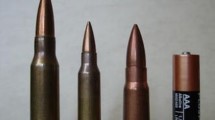Abstract
Ballistic wound is defined as the body damage caused by the penetration of an ammunition. The damage is related to the open trauma and to the energy transmitted by the projectile.
Access provided by Autonomous University of Puebla. Download chapter PDF
Similar content being viewed by others
1 What You Should Know
Ballistic wound is defined as the body damage caused by the penetration of an ammunition. The damage is related to the open trauma and to the energy transmitted by the projectile.
It depends on [1]:
-
Projectile characteristics (mass, velocity, structure, rotational spin, ability to deform or also to fragment, etc.) (Fig. 34.1);
-
The potential presence of intermediate barrier before or after penetrating the body (ballistic protection, bones, etc.)
-
The tissue penetrated by missile (vascular, visceral, orthopaedic, neurologic wounds, etc.).
Mapping the path of the missile inside the body and building up wound hypothesis based on the appearance of orifices and their number is too arbitrary to accurately guide the management [2].
Hunting rifles and guns called “less-lethal” can also cause severe trauma, especially at short distances.
2 What You Should Understand
Given the early death onset (almost 80% in the first 30 min), the “preventable” nature of some deaths, as well as the huge risk if the zone is not secured force the emergency team to consider medical as well as “tactical” issues.
The medical objectives are:
-
At prehospital level: look for and manage such preventable death causes (bleeding, airway obstruction, and tension pneumothorax) then immediately evacuate patient(s), whilst maintaining therapeutics (shock management, prevention of hypothermia, coagulopathy, etc.), to the adapted surgical facilities [3];
-
At hospital: continue resuscitation, start surgical procedures and perform complete investigations (better include a CT-scan imaging if the patient is stable or stabilised enough).
3 What You Should Do on Scene
“SAFE MARCHE RYAN” concept can be used to guide and prioritise prehospital actions, in particular in mass casualty and/or when the threat persists or is uncertain [2, 4].
-
S:Security→Protect yourself, help (without exposing yourself) the injured find shelter;
-
A:Analyse the situation→What is the threat? How will it evolve? Any retreat zones? Where are the officers in charge of each team (EOC, MED, COPG)? What are the inter-service communication means (radio channels, direct contact, etc.)?;
-
F:Free from danger—Law enforcement→What are the safety instructions? What are the common manoeuvres to extract and protect victims and/or how can emergency teams access scene (jointly defined by first EOC, first MED, and first COPG, then adjusted according to the situation development)?;
-
E:Evaluate→Sort and tag victims to prioritise management and evacuation of the most critical;
-
M:Massive bleeding→Carefully look for and immediately stop all bleedings easy to reach by prehospital tools (tactical tourniquet, pneumatic tourniquet, haemostatic packing, compression, junctional tourniquet, scalp suture, pelvic belt, etc.);
-
A:Upper Airways→Maintain upper airways open. Use simple measures (Guedel cannula, recovery position, etc.) or elaborated like intubation or insertion of subglottic catheter whenever needed;
-
R:Respiratory/Thorax→Make sure there is no tension pneumothorax, treat with exsufflation or thoracostomy (chest tube); oxygen therapy for respiratory distress;
-
C:Shock→In case of haemorrhagic shock, maintain systolic blood pressure above 80–90 mmHg using blood products (better use whole blood if available, freeze dried plasma and/or packed red blood cells otherwise), failing that, small volume resuscitation using crystalloids; administer 1 g of tranexamic acid; administer vasopressors if needed;
-
H:Hypothermia→Prevent hypothermia by all means (shelter, isothermal blankets or heat sheets, warm the infused fluids, etc.); measure the temperature;
-
E:Evacuation→Immediately evacuate victims starting with those whose bleeding cannot be stopped;
-
R:Re-evaluation→Fill in a field medical card for every victim, monitor, and re-evaluate the victim throughout the management;
-
Y:eYes, ENT lesions→Look for and treat ocular and ENT injuries, and functional impairment;
-
A:Analgesics→Evaluate and treat pain, immobilisation;
-
N:cleaN→Topical care, antibio-prophylaxis by 2 g of Amoxicillin-Clavulanate (or Dalacin + Gentamycin if allergic to penicillin).
References
Cordier PY, Prat N, Daniel C, Peytel E (2017) Ballistic wounds. In: Julien H (ed) Manuel de médecine de catastrophe. Lavoisier, Paris
Pons F (2018) War weapons specificity and wounds treatment. In: Mass violence by war weapons. Manuel for health professionals. Uncommon health crisis. Ministry of Health, Paris
Travers S, Ernouf C (2017) Prehospital management of shooting casualty. In: Julien H (ed) Manuel de médecine de catastrophe. Lavoisier, Paris
Val de Grâce Military Academy (2019) Recommendations for teaching combat rescue. Edition September 2019
Author information
Authors and Affiliations
Editor information
Editors and Affiliations
Rights and permissions
Copyright information
© 2022 The Author(s), under exclusive license to Springer Nature Switzerland AG
About this chapter
Cite this chapter
Travers, S. (2022). Ballistic Wounds: Management Principles. In: Julien, H.F. (eds) Disaster Medicine Pocket Guide: 50 Essential Questions. Springer, Cham. https://doi.org/10.1007/978-3-031-00654-8_34
Download citation
DOI: https://doi.org/10.1007/978-3-031-00654-8_34
Published:
Publisher Name: Springer, Cham
Print ISBN: 978-3-031-00653-1
Online ISBN: 978-3-031-00654-8
eBook Packages: MedicineMedicine (R0)





